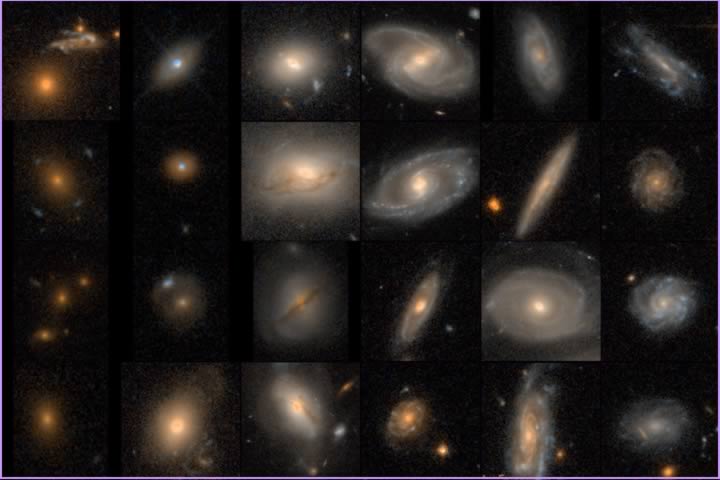 |
 |
Mosaic of AEGIS galaxy images from HST / ACS showing a range of normal galaxy types This mosaic shows examples of the many types of normal galaxies. The galaxies that you see here are dominated by two visible components: a fuzzy sphere of stars called a "bulge", and a flattened disk of rotating stars. Typically the stars in a galaxy bulge have reddish colors, while the disks tend to be more blue. In this image, the galaxies in the left-most column are completely bulge with no disk at all, while the galaxies in the right-most column have very small bulges that are barely visible at the centers of their disks. The galaxies in the middle have both clear disks and sizeable bulges. Galaxies with orderly disks are "spiral" galaxies, while the fuzzy featureless galaxies to the left are known as "elliptical" galaxies. The disks appear bluer because they are the site of ongoing star formation. Massive stars are very bright and very hot, which gives their light a blue color, but they also have very short lifetimes by stellar standards. After several million years, they have burned through their supply of nuclear fuel and they explode spectacularly as supernovae or collapse into black holes. More modest stars like the Sun burn more slowly and at lower temperature, but they will live for 10 billion years, long after the massive stars have disappeared. Because they are cooler, the light that they produce has a redder color. The disks of the galaxies toward the right of the image are the site of ongoing star formation, thus the population of young stars is continually being replenished and the disks appear blue. In contrast, the galaxies at the far left have no disks. Star formation in these galaxies ended some time ago, and all of the bright hot stars have died out. Only the smaller, cooler stars remain giving these galaxies a red color. The galaxy in the top left corner of the image is a typical red, bulge-dominated galaxy, but it has a companion galaxy that is highly irregular and may be a galaxy that has been disturbed by a close encounter with another galaxy. From the image alone, it is difficult to tell whether these two galaxies are genuine companions or whether they are just along the same line of sight with one galaxy much closer to us than the other. The galaxy in the image below it is another smooth red galaxy. However, if you look closely you can see four blue spots around the galaxy, as though they were at the points of a giant 'X'. This is known as an "Einstein Cross", and is an example of a gravitational lens. The blue spots are actually multiple images of a single blue galaxy that is behind the red galaxy in the center. The large mass of the red galaxy acts like a lens, bending the trajectory of the light from the blue background galaxy such that we see it in pieces around the red lensing galaxy. The galaxies in the second column also have large bulges. The two at the top of the column have bright central points that are bluer than the rest of the galaxy. These galaxies may either have a cluster of young, blue stars at the center, or they may contain massive black holes that are surrounded by hot disks of gas which are shining brightly as they slowly spiral into the black hole. The bottom two galaxies in this column are interacting with other galaxies. The upper of the two has a bluer companion galaxy that is in the process of merging with the larger galaxy---you can see stars being stripped off of the bluer galaxy into a halo around the larger red galaxy. The lower of the two has a plume of stars toward the upper right, an indication that it recently underwent a merger similar to the one above it. The third column contains galaxies that are dominated by bulges, but that have clear indications of disk-like structure. The galaxy at the top has a bar structure at its center, similar to the top two spiral galaxies in the column to its right. The other three galaxies in the column all have dark bands of dust that obscure some of the bulge starlight. These bands are disks of dust viewed edge-on. The galaxies in the next column to the right have clear spiral disks combined with large bulges. The two galaxies at the top of the column have bar-like structures in their centers, and are similar to what we would see if we could look at the Milky Way from a distance. The right-most two columns of galaxies are increasingly dominated by disks, with only very small reddish bulges at the center. |